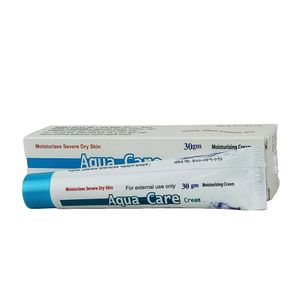Aqua Uses, Dosage, Side Effects and more
Carboxymethylcellulose Sodium & Hypromellose both of them are polymer in nature. It is a clear and colorless aqueous solution. This medication lubricates the surface of the eye in the same way as natural tears. It can therefore be used to relieve the dryness and pain associated with reduced or abnormal tear production.

| Attribute | Details |
|---|---|
| Trade Name | Aqua |
| Generic | Carboxymethylcellulose + Hypromellose |
| Weight | 0.25%+0.3%, , 0.025% |
| Type | Eye Drops, Tooth Paste, Ear Drops |
| Therapeutic Class | Drugs for Dry eyes |
| Manufacturer | Opso Saline Ltd, Perch Laboratories Ltd, Leeford Healthcare Ltd |
| Available Country | Bangladesh, India |
| Last Updated: | January 7, 2025 at 1:49 am |
Uses
This medication is used to relieve the dryness and pain associated with reduced or abnormal tear production.
Aqua is also used to associated treatment for these conditions: Dry Eyes, Ocular IrritationDry Eyes, Ocular Discomfort, Ocular Irritation
How Aqua works
Carboxymethylcellulose binds to the surface of corneal epithelial cells via its glucopyranose subunits binding to glucose receptors GLUT-1 . The residence time of carboxymethylcellulose bound to corneal cells is approximately 2 hours as indicated by a short-term binding assay . Binding of carboxymethylcellulose to the matrix proteins stimulated corneal epithelial cell attachment, migration, and re-epithelialization of corneal wounds .
Promotes corneal wetting by the stabilization and thickening the precorneal tear film and prolonging the tear film breakdown time, which is usually shortened in dry eye conditions. Hypromellose also acts to lubricate and protect the eye .
The surface active properties of the vehicles found in artificial tears solutions act to stabilize the tear film and increase tear viscosity to prevent delay tear evaporation and delay tear drainage .
In the intact eye, the corneal surface is moistened primarily by the mucin that is produced in the conjunctiva. Mucin is adsorbed on the corneal surface and forms a hydrophilic surface. This creates a moisture barrier. In the typical dry eye, and particularly in case of mucin deficiency, the application of artificial tear fluid is highly recommended. Both its surface activity and its adsorptive capacity make hypromellose optimal for this use. Hypromellose has a physical-chemical action and leads to, in an aqueous solution, a reduced surface tension as well as an increased level of viscosity. Hypromellose adheres well to the cornea and conjunctiva and provides ample moisture. Irritation symptoms caused by blinking, which occur in the case of tear fluid deficiency, are therefore decreased and symptoms of epithelial desiccation are also alleviated .
Dosage
For Adults and Children: Instill 1 or 2 drops in the affected eye(s) as needed.
How Long Does It Take to Work?
How Long Does It Take to Work? see here Aqua
Side Effects
Common side effects are blurred vision, matting or stickiness of eyelashes.
Toxicity
Rat oral LD50, rabbit dermal LD50, and rat inhalation LC50 of sodium carboxymethyl cellulose are 27000 mg/kg, >2 g/kg, and >5800 mg/m^3 (4 hours), respectively .
LD 50 (Rat): > 5 g/kg .
Hypromellose is considered low toxicity to non-toxic .
Adverse events may include blurred vision and contact dermatitis . Hypersensitivity and intolerance reactions may occur (for example, eye burning, pain, increased lacrimation, a sensation of foreign body, conjunctival hyperemia, eyelid swelling, pruritus). The stickiness sensation of the eyelids, the decreased sense of smell, photosensitivity .
Precaution
If you experience eye pain, changes in vision, continued redness or irritation of the eye or if your symptoms continue for more than 3 days or become worse, check with your doctor.
Interaction
No information is available.
Hypromellose can be used in combination with contact lenses. No compatibility study with lens material is available.
Volume of Distribution
No pharmacokinetic data available.
Elimination Route
No pharmacokinetic data available.
Not systemically absorbed .
Half Life
No pharmacokinetic data available.
Clearance
No pharmacokinetic data available.
Elimination Route
No pharmacokinetic data available.
Pregnancy & Breastfeeding use
Carboxymethylcellulose Sodium & Hypromellose have not been shown to cause birth defects or other problems during pregnancy and breastfeeding.
Contraindication
Known sensitivity or allergy to any ingredient of the formulation.
Special Warning
This drug does not cause different side effects or problems in children than it does in adults.
Acute Overdose
Since CMC is pharmacologically inert and not expected to be absorbed systemically, systemic effects from topical overdose are not expected from the administration of Carboxymethylcellulose sodium (Cellufresh) 0.5%. Additionally, no toxic side effects are expected should accidental systemic overdose occur.
No case of overdose has been reported.
Storage Condition
Store in a cool, dry place and protected from light, Keep out of the reach of children, Do not use more than 4 weeks after opening.



